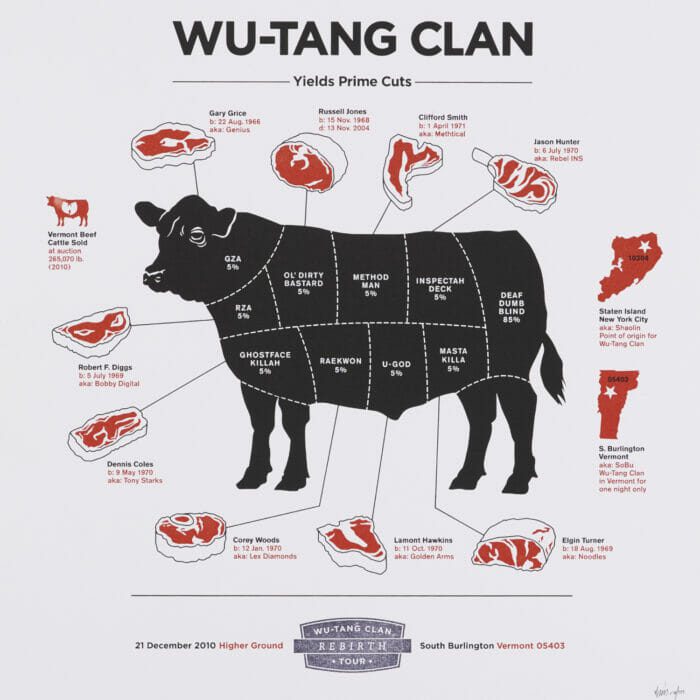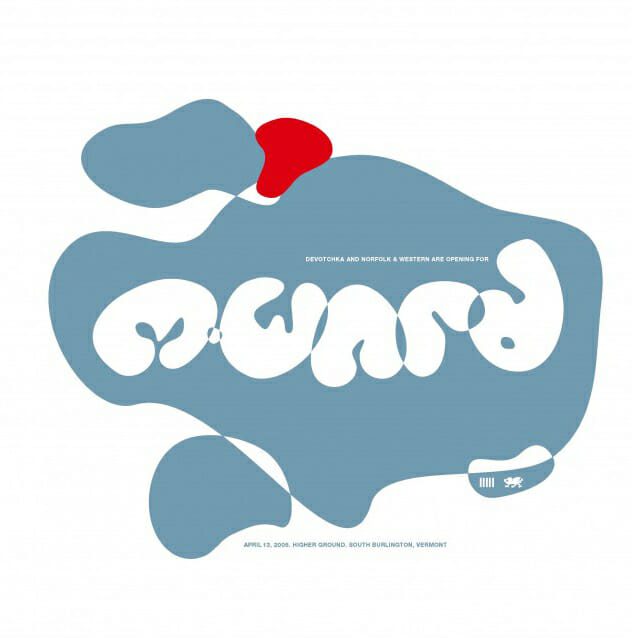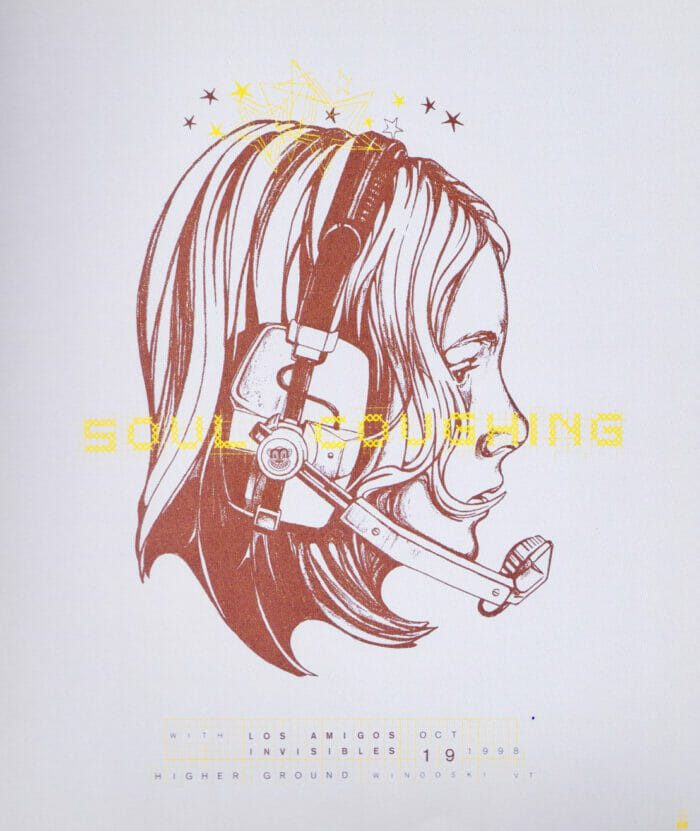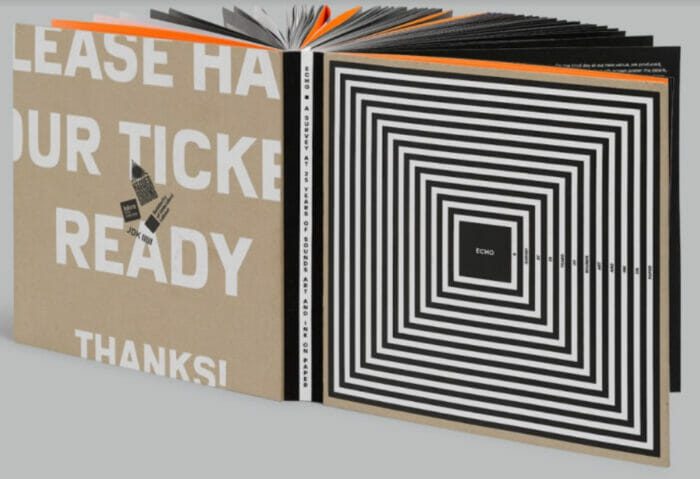
Ween (Tom Wender), Sturgill Simpson (Andrew Lakata)
***
A new limited-edition art book celebrates a quarter-century of music at Vermont’s Higher Ground. Over the past 25 years, the independent music venue has distributed free commemorative posters at the end of certain shows. Higher Ground has worked with Solidarity of Unbridled Labour (formerly JDK Design) and Iskra Print Collective to create these mementos, which arrive with an element of surprise, since they are not given out every night, nor are they announced in advance.
Echo: A Survey at 25 Years of Sounds, Art and Ink on Paper collects these 367 posters, with all proceeds directed to the Iskra Print Collective—a local nonprofit that teaches printmaking.
“There are a couple of things that make this book unique, just by the environmental conditions,” suggests Higher Ground’s Alex Crothers. “A lot of times, these books focus on a band or you’ll have a design firm that is doing designs for different bands, but they tend to stay within one genre. Those are great poster books—they’re beautiful and they’re fun to look at. But what makes this one a teeny bit unique is that we’re in the small market of Burlington, Vt. We’ve often effectively been the only music venue in town, which means we’ve booked an incredibly wide range of music. So not only do you get this time capsule of the Burlington music scene, but you also get a beautiful commemorative poster book that has Norah Jones next to the Wu-Tang Clan, next to Dar Williams, next to Public Enemy. Then you combine that with the fact that we were fortunate enough to strike up this collaboration with an amazing cutting-edge design firm that also happens to be in Burlington. That’s what created the kismet of this series that’s been chugging along for 25 years.”
What led to the initial decision to hand out posters? Before you did this at Higher Ground, I had associated it with Bill Graham and the Fillmore.
I had been to the Fillmore in San Francisco, and I had experienced that. I thought it was such a nice touch and a really nice treat.
So when Higher Ground started, I wrote a letter to this design firm in town that Michael Jager led. I still have a copy of that letter—it’s in the book. Luckily for all of us, he opened the letter, read it and responded. The relationship began from there.
We also added a little twist. It’s been so long that I can’t say any of this was really intentional, but we decided not to make posters for every show. We have no real guide rails for the process, meaning we give them complete creative control. We’re not using the posters for marketing. They’re not being sold. There’s absolutely no commerce associated with them.
We just decided to do these beautiful, silk-screened, limited-edition prints that are, in most cases, signed and numbered. Then we hand them out for free at the end of the night. Certainly, the germ of the idea came from Bill Graham and the Fillmore. Then we put our own take on it.
Wu-Tang Clan (Chris Patrelow)
How do you decide which shows should generate a poster?
It’s a little bit like jazz. There aren’t any strict rules. Sometimes we’ll do four posters in a month and other times we’ll go six months without doing any posters. Part of what keeps the collaboration between Higher Ground and Solidarity fresh and exciting is that we don’t set a lot of rules. So it continues to evolve and breathe as it needs to.
Over the years, Michael has reinvented his design studio. It used to be called JDK and they used to have offices in New York, Burlington and Portland, Ore., with 150 employees. Then he blew it all up and made it small again. So he went through a transition at one point where the poster series slowed down, though we never even talked about it.
There have also been times when Higher Ground didn’t have the money. We go out of pocket on these posters every time we make them. So there were times when we were barely making payroll, and we slowed down.
But all things being equal, generally the way it works is that either they can come to us because there’s a designer on staff that is paying attention to our calendar and says, “Hey, I see you’ve got that artist coming to town. I’m a huge fan. I’d love to do a poster.” Or, more often, we’ll say, “Here’s the next three months,” and then we will highlight a couple of artists who are coming through. It might be a young artist on their way up that we’re excited about and we hope to develop a long-term relationship with that artist in Burlington. Or we feel like we really captured a moment in time—the artist is moving very quickly, and we want to make a poster to celebrate the fact that we got them to come to Burlington and play a show here before they go on to do other crazy, massive things. A few examples of that are Maggie Rogers, Phoebe Bridgers, Alabama Shakes and Sturgill Simpson, all of whom we got right on the cusp. The other thing we’ll do is that if we’ve got an artist who’s coming in for a big underplay—which used to happen a little bit more then it happens now—we’ll say, “Oh, man, we’ve got to do a poster.” That happened with The Black Crowes, Bob Weir and Rob Zombie.”
Do you ever suggest a metaphor? Not because they can’t do it on their own, but since it would be fun for you to have an idea realized in some way?
Very rarely. What makes this so compelling for them as a design firm—I’m going to speak for them, which is something I try to not do—is that this is a rare opportunity for a designer to design however they’d like. Most of the time, whatever our job might be, we all have to answer to somebody. So I encourage them to get as creative as they want because you just don’t get these types of opportunities.
The only thing that’s required is the name of the artist, the name of the support band, the date, the location and Higher Ground. On some of the posters, that’s practically illegible.
Back in the early days of the internet, when it was harder to get information about an artist, I might have given them some biographical or musical information. But I can’t think of a time when I’ve ever been like, “I think you should put a giant flower on the poster because that feels like it represents the visual aesthetic of this band.”

M. Ward (John Siddle)
There’s an M. Ward poster I’m thinking of that might be difficult to read at first but stands on its own as a creative expression.
A big part of what makes this book different from other concert poster art books is that almost every other concert poster art book is operating under the guidelines and restrictions of the fact that the poster needs to serve a marketing or commerce purpose. These posters don’t have to serve any purpose except to exist and be beautiful so that they can be given to fans.
Even if we’ve stumbled one or two times, as crazy as the posters have gotten, they’ve almost always still landed as something. We’re giving them out in the parking lot after this magical moment that people have just experienced at the venue.
With the book and the celebration of Higher Ground’s 25th anniversary, I’ve heard a lot of anecdotal feedback from people who are like, “Wow, I have these hanging all over my walls.”
Just yesterday, I got a photo from a friend who lives in Boston. She was in the Burlington area in those early days, and she sent me a picture of a Soul Coughing poster hanging in what looked like her kitchen.
We put a lot of thought, love and money into making these, and we give them out with the hope that people will appreciate them and treat them as the works of art that they are. That Soul Coughing poster was made in 1999. So for it to still exist as a piece of art on someone’s wall 24 years later is something pretty special.

Soul Coughing (Byron O’Neill)
The book is framed by some reflections from Jeff Tweedy, who writes in part, “One cannot create without creating other creators.” That’s simple and direct but also pretty weighty.
I’ve read it dozens of times now, and it still makes the hair on the back of my neck stand up. To your point, it’s a very simple but profound statement. I don’t think it’s something that a lot of people think about. But it really is the nature of what we’re all doing.
A lot of us are just obsessed with going to see live music. One thing I’ve learned across time is that it’s very hard to put people in a box. For instance, there is a jamband community but jambands are rarely the only thing those fans go to see. They also love to see Tool, Metallica, Wilco or some dance-pop music. It’s amazing what spirals out of that once you really start getting into the world of seeing live music.
Part of the attraction and the draw is that you’re watching someone create onstage and it’s inspiring. Hopefully, that’s also an extension of Jeff’s quote— whether it’s in a club of 500 or an arena of 18,000, all of those people are walking away from that experience being inspired to go do something and create on their own.

